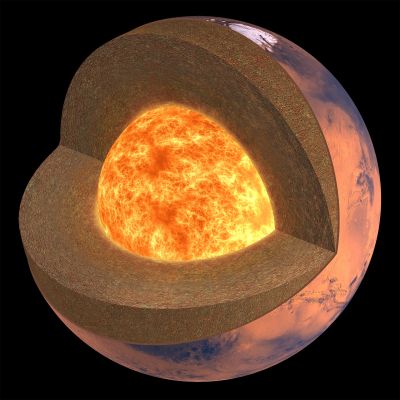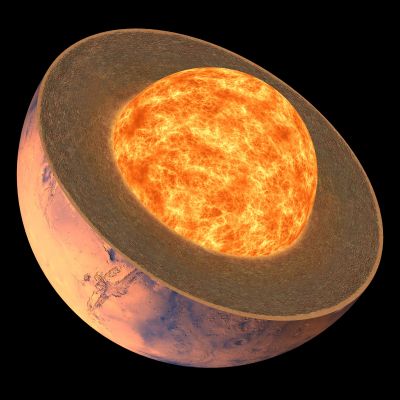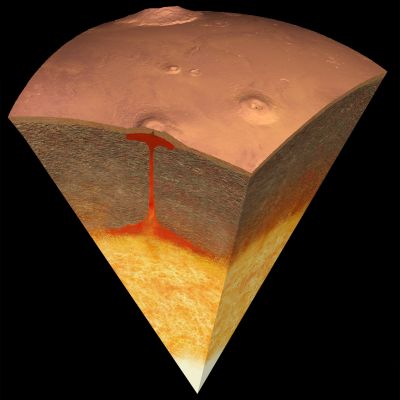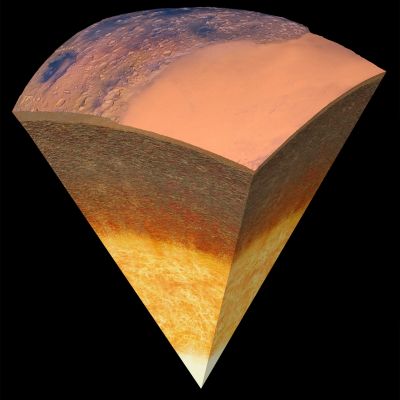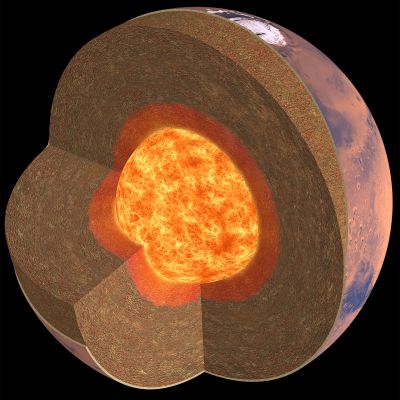Models of the internal structure of Mars
The mystery of Mars’ interior
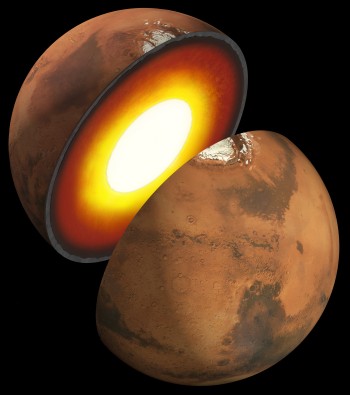 Internal structure of Mars (© NASA).
Internal structure of Mars (© NASA).
Unlike our own planet, whose internal structure has been well defined, our knowledge of the interior of other planets in the solar system is as yet very limited. Geophysicists gaze at them longingly, dreaming of shedding light on their internal structure just as they have the Earth’s. Because of its similarities and differences with our own planet, Mars is a high-priority target for them.
Up to now, the only measurements relating to Mars’ internal structure have provided information on its mass and diameter (needed to calculate density) and a parameter that geophysicists call the moment of inertia. This was determined from research on the planet’s rotation using probes placed on its surface (see InSight’s RISE experiment). This type of measurement gives geophysicists an idea of the way mass is distributed inside a planet.
Orbiting probes, sensitive to the slightly bumpy nature of globes and the unequal distribution of mass (which modifies the intensity of the gravity field), have only managed to confirm that Mars has the same basic envelopes as the Earth and to estimate the average thickness of the Martian crust.
The presence of a global magnetic field is generally a good indicator of the existence of a molten metal core subjected to convective motions. However, neither Mars nor Venus has such a field.
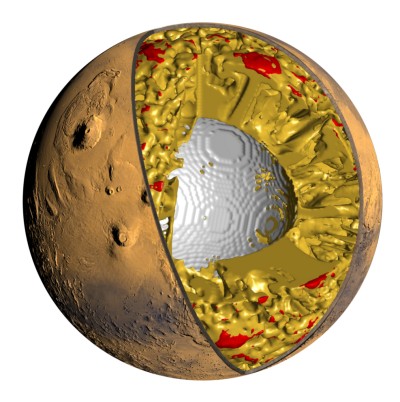 Numerous uncertainties remain about the structure and activity of the Martian mantle (© Ana Plesa/DLR).Finally, fragments of rocks ejected from the surface of a planet into space can sometimes land up on the Earth. If they are picked up and identified, these extraterrestrial stones (known as meteorites) can provide geophysicists with valuable information. The mineralogical analyses carried out on Martian meteorites have allowed extrapolations to be made on the nature of the crust and mantle. Important contributions have been made by geochemical measurements taken by orbiting satellites, in addition to in situ analyses carried out on the surface of the Red Planet by the Curiosity rover among others.
Numerous uncertainties remain about the structure and activity of the Martian mantle (© Ana Plesa/DLR).Finally, fragments of rocks ejected from the surface of a planet into space can sometimes land up on the Earth. If they are picked up and identified, these extraterrestrial stones (known as meteorites) can provide geophysicists with valuable information. The mineralogical analyses carried out on Martian meteorites have allowed extrapolations to be made on the nature of the crust and mantle. Important contributions have been made by geochemical measurements taken by orbiting satellites, in addition to in situ analyses carried out on the surface of the Red Planet by the Curiosity rover among others.
However, despite the efforts undertaken to attempt to understand what is hidden in the depths of the Red Planet, there remain many unknowns. The limits and constraints imposed by the measurements carried out to date do not enable us to design even a very simple model of Mars’ internal structure. The exact size and composition of the internal envelopes remain a mystery, because measurements of gravity do not result in a single model of the internal structure. Several solutions—sometimes significantly different—can explain, or at least remain coherent with, the measurements taken.
The acquisition of new information through the application of techniques such as seismology, suited to sounding the inner depths of planets, is thus crucial to extend our knowledge of the mechanisms governing the formation and evolution of planets.
Yet, as paradoxical as it may appear, of all the missions that have landed on Mars up to now, only one—Viking 2—enabled an operational seismometer to be placed on the surface. Unfortunately, throughout its operational life, the instrument only recorded a single event that could have been caused by a marsquake. However, even today—40 years later—this hypothesis is a subject of controversy among the scientific community, and the mystery of the true nature of the vibrations recorded remains to this day.
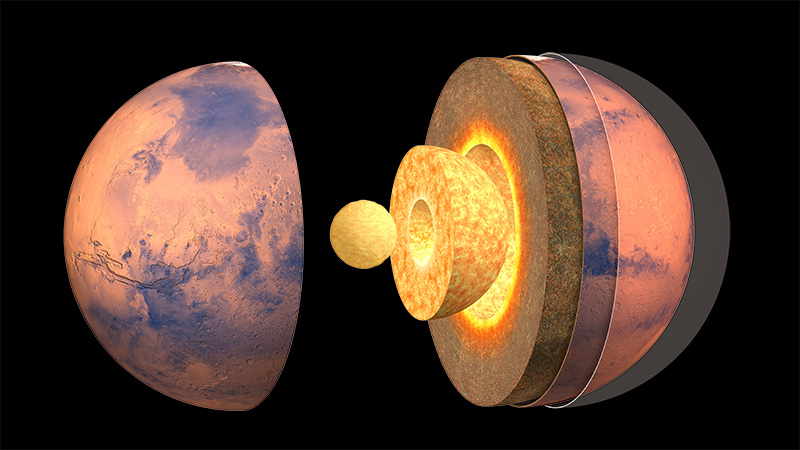 Mars's internal structure : core, mantle, crust and atmosphere (© IPGP/David Ducros).
Mars's internal structure : core, mantle, crust and atmosphere (© IPGP/David Ducros).
Mars, a planet similar to Earth?
As we saw in the previous article, the internal structure of Mars is similar to that of Earth. It has three distinct layers: going inwards from the outside, there is a relatively thin rocky crust, a mantle and finally a metal core.
Many questions remain unanswered, however, when we try to define this structure in more detail. How big is the core, and what is it made of? Is it completely solid, still liquid or, like Earth’s core, does it have a solid inner core surrounded by a liquid envelope?
What is the Martian mantle made of? Is it subject to convective motions or does it remain immobile, transferring the heat accumulated in the centre of the planet outwards quite simply by thermal conduction? Are there any major discontinuities in the mantle, linked to significant changes in its composition?
How thick is the Martian crust? Is it homogeneous or, on the contrary, stratified (with ice lenses or alternating strata of sedimentary rock and volcanic flows)? All these questions, and many more, are essential because they are directly linked to the conditions present at the origin then development of the Red Planet over billions of years. There is also a very strong relationship with the planet’s habitability, i.e. Mars’ ability to host and sustain the development of life.
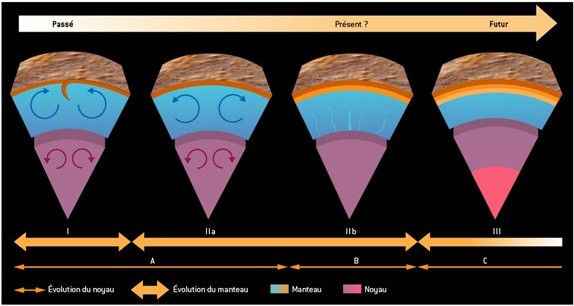 A hypothetical sequence showing the evolution of Mars’ internal structure (© rights reserved).
A hypothetical sequence showing the evolution of Mars’ internal structure (© rights reserved).
The Martian crust
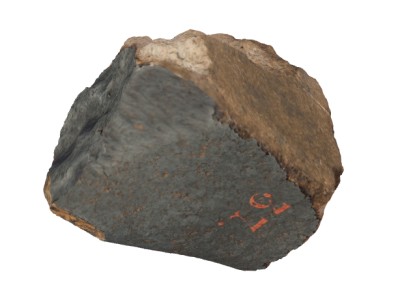 The first Martian meteorite found on Earth in 3D (Chassigny, France) (© IPGP/MNHN).
The first Martian meteorite found on Earth in 3D (Chassigny, France) (© IPGP/MNHN).
A planet’s crust is formed by the melting of rocky material making up the upper mantle, followed by an upwards expulsion of liquid magma which then crystallizes as it cools down.
When you start looking in more detail, the mechanisms behind the formation of planetary crusts are complex. Thus it is that on Earth, the oceanic crust upon which the oceans are founded is formed differently from the continental crust, which is much older and of a different composition.
The Martian crust is thought to be between 30 and 100 kilometres thick depending on the hemisphere, with a mean thickness of 65 kilometres, a value that is closer to that of the Earth’s continental crust. However, its composition—basaltic rather than granitic—resembles that of the Earth’s oceanic crust. InSight’s seismic measurements will measure the crust’s thickness to within a few kilometres, and will reveal whether there is any stratification, a phenomenon which has not yet been observed.
 Simulation of Martian magma plumes (© rights reserved).
Simulation of Martian magma plumes (© rights reserved).
Another fundamental difference is that the Martian crust appears to be completely motionless, whereas Earth’s surface is divided up into lithospheric plates that are constantly moving relative to each other.
It may appear that the geological machinery in motion on Mars has been simpler than that on Earth. The Red Planet is thought to be surrounded by a single plate that forms a thick, rigid outer shell. However, the mechanism behind the formation of this single crust remains a mystery to this day.
Several different scenarios may be hypothesized, each leading to a different crust thickness and a specific efficiency with regard to the planet’s capacity to dissipate internal heat.
If we assume that a very early, fleeting plate-tectonics process occurred on Mars (remembering that this is a subject of much controversy), the Martian crust would be fairly thin, and the planet would then have been able to efficiently evacuate its internal heat, at least at first.
A second possibility is that, without breaking up the lithospheric surface into moving plates yet involving the convection of materials in the mantle, the planet formed a moderately thick, motionless crust. In this “stagnant lid” regime, heat is evacuated normally but less efficiently than with plate tectonics.
Finally, there is a third case, linked to the appearance of an ocean of magma. Shortly after its accretion, Mars was constantly colliding with great violence against asteroids and huge bodies. Glowing red-hot as a result of the energy released, the rocky materials are thought to have melted, becoming a widespread ocean of magma of unknown depth. As it cooled down, this ocean is assumed to have formed a very thick crust, some traces of which may remain today on Mars.
Deeper down, in the mantle, a specific mechanism may have been at work. The upper part of the mantle may have solidified, forming aggregates denser than the lighter, underlying materials. Naturally unstable, these blocks of agglomerated matter could have sunk down towards the centre, causing material in the depths to rise to the surface and possibly even triggering convection by turning the mantle upside down. In this scenario, the very thick crust acts as an insulating layer, preventing heat exchange with the exterior. This problematic situation could quite easily, as we shall see later, be responsible for the disappearance of the magnetic field created by the core.
By accurately determining the thickness of the Martian crust, and measuring today’s heat flow, it will be possible to dismiss certain scenarios. Needless to say, the reality is no doubt more complex than these scenarios, and it is entirely possible that in the 4.5 billion years of its existence, Mars may have gone through different stages, all inextricably linked to one another. Distinguishing and understanding them may prove a lengthy and complicated business.
The mantle
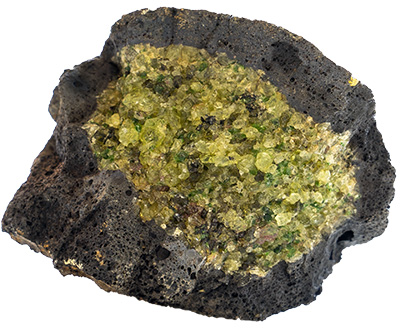 Peridotite in terrestrial basalt (© IPGP/Philippe Labrot).
Peridotite in terrestrial basalt (© IPGP/Philippe Labrot).
Sandwiched between the crust and the core, the Martian mantle must have a similar composition to that of Earth, going by the composition of Martian meteorites that have crashed down onto our planet. It could also be made up of olivine-rich rocks known as peridotites.
However, numerous questions remain as to its composition and structure. It could theoretically contain a discontinuity similar to that between the Earth’s upper and lower mantle, with a change in the olivine’s phase. However, because Mars is smaller than the Earth and its field of gravity is weaker, the Martian mantle is perhaps not deep enough for such a discontinuity to exist (it being absolutely crucial on Earth).
Theoretical simulations show that the Martian mantle should still be subject to convective motions, the planet having a sufficient amount of heat to fuel such motions. However, unlike the Earth, this convection has perhaps not been able to correctly homogenize the mantle’s material, so it is possible that the Martian mantle contains several independent deposits or reservoirs that were never in contact with each other. Geophysicists are also placing their hopes in InSight to resolve this question.
The mantle is a compartment that plays a major role in the development of a planet. By partly melting, the rocky material in the mantle forms magmatic fluids that infiltrate upwards until reaching the crust. There, they can trigger huge volcanic phenomena able to change the climate or foster life forms able to survive. Furthermore, as we shall see, by playing the role of heat exchanger between the core and the exterior, the mantle also has a huge influence on the planet’s magnetic field.
One of the InSight mission’s important objectives is thus to accurately determine the Martian mantle’s thickness, its composition and the presence or absence of strata.
Core and magnetic field
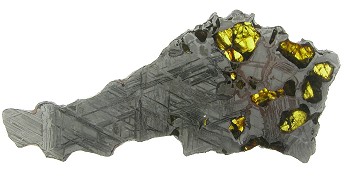 Ten-centimetre slice of a Glorieta Mountain pallasite (© Luc Labenne / Société Labenne Météorites).
Ten-centimetre slice of a Glorieta Mountain pallasite (© Luc Labenne / Société Labenne Météorites).
Nowadays, Mars no longer has a global magnetic field like the one surrounding Earth.
The only measurements taken from orbit by the US Mars Global Surveyor probe have revealed the existence of a fossil magnetization in the rocks of the southern hemisphere, which go back several billion years. The younger rocks in the northern hemisphere, however, show no trace of any remanent magnetic field.
The observations made appear to clearly indicate that in a distant past, shortly after its formation, Mars must have had a global magnetic field capable of protecting the atmosphere from the abrasive solar wind and thus helping to establish the climatic conditions allowing liquid water to flow. Such a magnetic shield was no doubt generated by a dynamo effect, i.e. the convection of a molten metal in the planet’s core. Over 4 billion years ago, Mars’ core must have been partly or fully liquid, and the contrast in temperature between the core and the mantle sufficiently strong to have triggered such convective motion.
There is no such magnetic field today, which indicates that something dramatic happened at the very heart of the planet around 4 billion years ago. At this point in time, we can only speculate about what actually occurred. It is possible, for example, that the planet cooled down so quickly that the core became motionless. The liquid layer crystallized, becoming so thin that convective motion stopped, leading to the definitive disappearance of the planet’s global magnetic field. In this case, the Martian core would have completely solidified. In the light of the latest data collected by satellites orbiting around Mars, this is not the most likely scenario. The planet’s gravitational response, as observed by orbiting probes, tends to favour the presence of a liquid state. The recordings of the SEIS seismometer flown on the InSight mission will help clear up this nagging uncertainty.
While a massive cooling of the planet’s interior can lead to the shutting down of Mars’ dynamo, another directly opposed scenario is also feasible. Convection can only occur if there is a sufficiently large temperature difference between the core’s centre and its edge or surface.
The core’s heat must be evacuated efficiently up through the mantle for convection to occur. On the other hand, if the mantle suddenly stops conducting heat effectively and forms an insulating layer, the core can no longer dissipate its own heat and the convection motions among the molten metal gradually disappear, along with the global magnetic field.
The Martian core could therefore be fully or partially molten despite the fact that the magnetic field disappeared billions of years ago. The situation is made more complicated by the fact that the core’s fate depends not only on the properties of the mantle, but also the composition of the core itself.
Mars in a Minute video series : What's inside Mars ? (© JPL-Caltech).
The study of iron meteorites having landed on Earth from the asteroid belt shows that planetary cores are mainly formed of iron mixed with a small quantity of nickel. As incredible as it sounds, these meteorites are thought to be fragments of the metal core of stillborn planets; bodies that had begun to form around the Sun but which were then torn apart by huge collisions. They therefore provide clues as to the composition of cores which, buried deep in the heart of planets, are completely inaccessible to direct human investigation.
Telluric planets such as Mars or the Earth contain not only iron and nickel, but traces of other elements such as silicon, sulphur or even hydrogen. Although in the minority, these elements could play a significant role in the fate of planets.
The geochemical models deduced from the analysis of SNC meteorites from Mars (shergottite, nakhlite and chassigny classes) suggest that the Martian core contains more sulphur than the Earth’s. A significant amount of this element may have migrated into the planet’s interior along with the molten iron, with major consequences. The more sulphur there is, the more liquid the core tends to remain, even when the temperature decreases. If the Martian core does contain a significant amount of sulphur, it may still be completely liquid. However, if the core contains little sulphur, the molten metal could have completely or partially solidified. The liquid and/or solid state of the Martian core therefore depends on its composition as well as the planet’s thermal evolution (i.e. its cooling over time).
The core’s size, which is unknown with any degree of accuracy, is however related to the conditions in which the planet was formed. It is also linked to the differentiation process, the crucial phase in the formation of a planet when very dense metallic elements separate from the rocky material to descend into its centre and agglomerate to form a core. The Martian core is considered to have a radius of about 1,700 kilometres, but its exact size is not known precisely, it being estimated to within 250 to 300 kilometres. InSight will reduce this uncertainty by at least a factor of four.
The Red Planet itself has a radius of 3,389 kilometres, so the core appears to take up quite a large part of its inner volume, even if proportionally speaking it is smaller than the Earth’s. This difference in size is probably due to the fact that part of the iron that could have sunk down into the core may have remained in the mantle, incorporated in iron-rich minerals.
As well as measuring the core’s dimensions, InSight will also provide information allowing the core’s density to be assessed more accurately. For the moment, it is estimated at 7 g/cm3 (+/- 1 g/cm3), a high density associated with a small core, in order to preserve the planet’s total mass.
By enabling geophysicists to accurately determine the size, state and composition of the Martian core, InSight will greatly advance our knowledge of an envelope of fundamental importance to the Red Planet and which no doubt holds the key to the specific fate of this stillborn body.
Three models of the core’s development
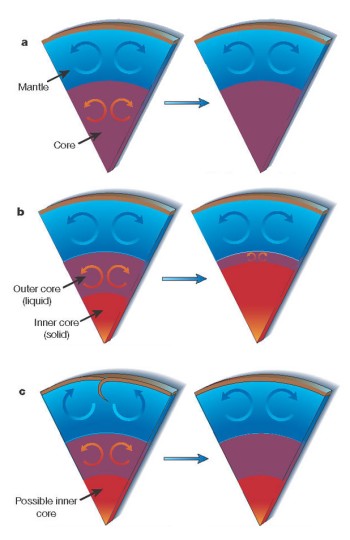 Three scenarios of the Martian core’s evolution (© rights reserved).
Three scenarios of the Martian core’s evolution (© rights reserved).
To conclude, let us consider three different models of the internal structure of Mars, all three of which are plausible in the light of the data available today but which may prove completely false when the first results of InSight’s SEIS seismometer reach the Earth..
The first model suggests a sulphur-rich metal core. This scenario suggests that once formed, Mars had a completely liquid core whose convective motions generated a global magnetic field. The mantle was also subject to convection, but the Martian crust did not break up into floating plates and no plate tectonics ever occurred.
As the planet cooled down, the liquid core’s convection decreased and finally stopped, leading to the disappearance of Mars’ magnetic field. The convective motions in the mantle may have continued, but it is also possible that the material making up the mantle also became immobile over time.
The second model is based on a sulphur-poor core. Mars’ internal structure would thus be similar to that proposed by the first model: a crust comprising a single plate covering the whole of the planet and a mantle subject to convective motions. Instead of being completely liquid, the core in this scenario has an external part that is liquid and whose convection is sufficient to create a global magnetic field, and an inner part that is solid due to the crystallization of the initial molten metal. The difference between this model and the first one is based on the hypothesis that, following the planet’s cooling, the core rapidly continued to gain mass, only leaving a liquid layer too thin to be able to host convective cells able to generate a magnetic field.
The third model, independent of the quantity of sulphur in the core, involves the appearance of a major mechanism that changes everything: plate tectonics, that allows the planet’s internal heat to be evacuated efficiently. In this scenario, the Martian surface—like that of the Earth—is divided up into mobile lithospheric plates. Under the crust, the mantle is subject to convective motions that contribute to plate movements. The core is composed of a convective liquid outer core and a solid inner core.
Following the efficient cooling of the planet’s interior, or due to a specific event such as a major collision, the mantle’s convection stops. This automatically leads to the cessation of plate tectonics and has a dramatic effect on the mantle’s convection, which also stops. The domino effect leads convective motions of the outer core’s molten metal to stop, leading to the disappearance of the global magnetic field.
The final result is the same for all the models, which is normal given that all three scenarios must lead to the final situation as we know it: Mars loses its protective magnetic field. Exposed to the abrasive solar wind, the atmosphere is lost in space, surface temperatures plummet, liquid water no longer flows and a global, definitive desertification process is triggered.




